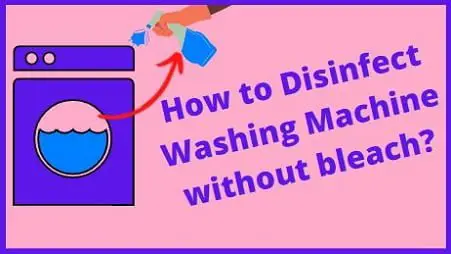If you want to disinfect your washing machine without using bleach, you can use vinegar.
Vinegar is a natural cleaner that is known for its antibacterial properties.
It can not only clean and disinfect your washing machine but it is also considered to be safer than other chemical-based cleansers. Furthermore, it’s much easier on your washing machine.
The main challenge that people face when disinfecting their washing machine without bleach is that they don’t know how to do it properly. They also don’t know what products or alternatives to use.
If you’re looking for a guide on how to disinfect your washing machine without bleach, this is exactly the right place.
Here’s what this article covers:
- How to clean and disinfect a top load washing machine?
- How to clean and disinfect a front load washing machine?
- Common questions that come to mind when disinfecting washers
- And more…
Table of Contents
Let’s get started.
Clean Top Loader washing machine without Bleach
Top load washing machines are a popular choice for many homeowners.
They are simple to use and can be very efficient when it comes to cleaning clothes. However, like all appliances, top load washing machines need to be properly cleaned and disinfected on a regular basis.
This is especially important if you have small children in your home, as they are more susceptible to bacteria and viruses.
One of the best ways to disinfect a top load washing machine is to use vinegar.
What You will need?
In order to clean a top load washing machine you simply need 3 items:
- White vinegar
- A clean cloth
- Water
Now that you have the above items ready, let’s follow the below steps to clean and disinfect the top load washer without using a single drop of bleach.
Clean detergent and fabric softener compartments
The first step is to clean the detergent and fabric softener compartments in your top load washer.
This will help to keep them functioning properly and will also help to prevent any bacteria or dirt from building up.
You can clean the compartments by using vinegar and water.
Simply mix 1 cup of vinegar with 1 cup of water and use a clean cloth to wipe down the compartments.
Once you have cleaned the detergent and fabric softener compartments, rinse them out with clean water.
Use Vinegar to clean the detergent compartment
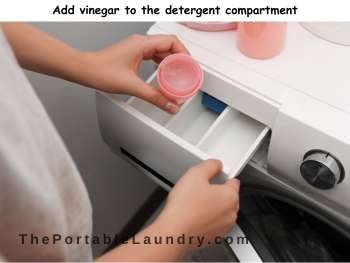
Once you have cleaned the fabric softener and detergent compartment, add 1 cup of vinegar to the empty washing machine.
If you have a larger washing machine, you can add up to 2 cups of vinegar inside your washing machine. Do not mix vinegar with any other cleansers, it will do more harm than good.
Also Read: 11 Things you must know about High-Efficiency Detergents
Set the hottest and Longest Cycle

It’s important to set the hottest and longest washing cycle when disinfecting your top load washing machine.
This will ensure that the vinegar is able to kill any bacteria or viruses that may be present.
Use the heavy-duty wash cycle if your washer has one. Having said that, most modern-day washers have a built-in drum clean feature. If your laundry machine has that feature use it.
Agitate and let it soak
Once you have added the vinegar, start the washing cycle for a few minutes so that the vinegar can mix with the water.
After a few minutes, pause the cycle and let the vinegar and water mixture sit in the washer for about an hour. This will give the vinegar time to work its magic.
Also Read: How to clean washing machine agitator?
Run the wash cycle
Once you have let the vinegar and water mixture sit in the washer for about an hour, it’s time to run the wash cycle. Doing so will remove any residual vinegar and dirt from the washing machine.
Wipe the drum and inner parts
Once the wash cycle is complete, wipe the inside of the washing machine with a clean cloth.
This includes the drum, door, gasket, and other inner parts. Be sure to pay special attention to the rubber seal as this is where most of the dirt and bacteria accumulate.
Also Read: How to clean a portable washing machine?
Dry the washing machine
Once you have finished running the wash cycle, it’s important to dry your top-loading washing machine.
This can be done by opening the door and letting the machine air dry. You can also use a clean towel to dry the inside of the washing machine.
That’s it! By following the above steps you can easily clean and disinfect your top load washing machine without using any bleach.
Also Read: Top Load VS Front Load detergents
Clean Front Loaders without bleach (front-loading washing machine)
Front-loaders are another popular choice for many homeowners. They are simple to use and can be very efficient when it comes to cleaning clothes.
Just like top load washers, front-load washers need to be properly cleaned and disinfected on a regular basis. Front-Load washers are more prone to bacteria and mildew build-up due to the way they operate.
The good news is that cleaning a front load washing machine is just as easy as cleaning a top load washer. All you need is vinegar, water, and a clean cloth.
What You Will Need
In order to clean a front-load washing machine, you will need the following:
- Vinegar
- A Clean cloth
- Water
Once you have the above items handy, follow the below steps to disinfect and clean a front loader.
Also Read: How to change a washing machine belt?
Add vinegar to the detergent compartment
Start by adding 400 ml of vinegar to the detergent compartment of your front load washing machine. If you have a larger washing machine, you can add up to 600 ml of vinegar.
Set the hottest and Longest Cycle
Next, run your washing machine on hottest and longest cycle. Doing so will ensure that the vinegar is able to kill any bacteria or viruses. Allow the cycle to complete.
Once the wash cycle is completed with a vinegar solution, run an empty wash cycle with only water so that vinegar and residues are removed.
Also Read: How to keep the washing machine in a small bathroom?
Wipe the detergent and fabric softener compartments
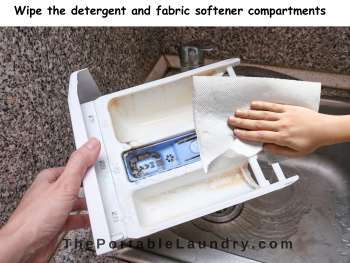
Once the empty wash cycle is complete, it’s time to clean the detergent and fabric softener dispensers. This can be done by using a clean cloth and vinegar.
Simply dip the cloth in vinegar solution and use it to wipe down the compartments. Be sure to pay special attention to the nooks and crannies as this is where most of the dirt and bacteria accumulate.
Remove and clean the lint filter
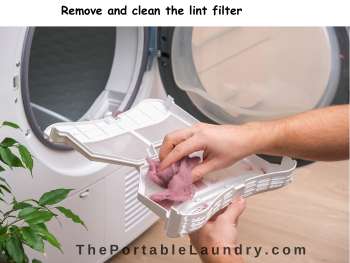
The lint filter is another important component of the front load washing machine that needs to be cleaned on a regular basis. Remove the lint filter and clean it with a vinegar solution.
You can also use a toothbrush to remove any stubborn dirt or debris. Once you have cleaned the lint filter, put it back in place.
Clean the rubber seal
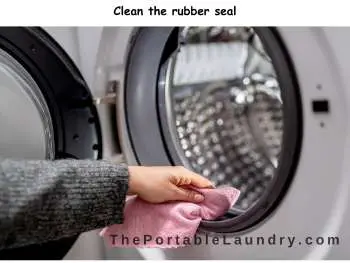
The rubber seal is another area where bacteria and mildew can accumulate. Use a vinegar solution and a clean cloth to wipe down the rubber seal.
Once you have finished cleaning the rubber seal, dry it with a clean towel.
Also Read: Are washing machines waterproof from outside?
Dry the washing machine
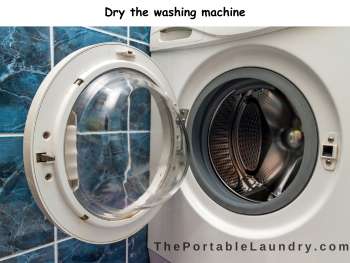
Once you have finished cleaning all the compartments, it’s important to dry your front loading machine.
It’s always good to keep the door open and let it air dry.
Clean Washing machine without bleach (Illustration Infographics)
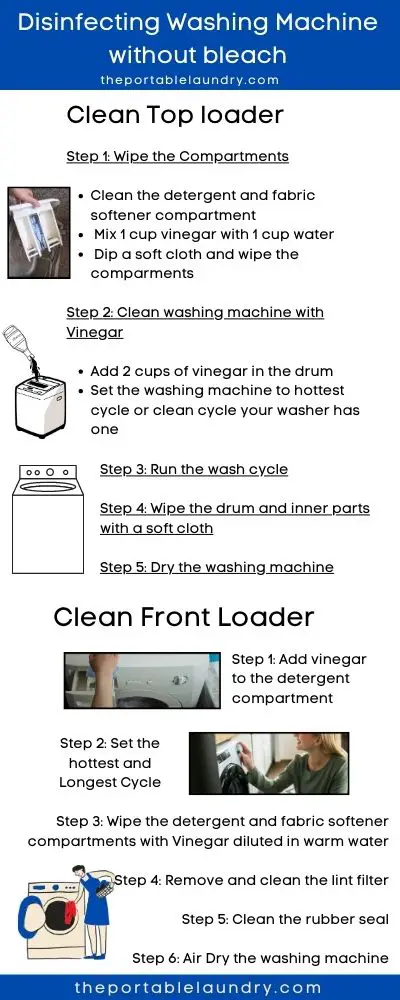
Alternate washing machine cleaner and disinfecting solutions (DIY Washing machine cleaners)
In order to clean your washing machine and sanitize it you can use below alternatives.
Distilled white vinegar
Vinegar Distilled White vinegar is a great all-purpose cleaning and disinfecting agent.
Set your washing machine to run a hot water cycle with two cups of white vinegar added to the detergent dispenser or the drum.
This will aid in disinfecting the machine and removing any soap residue or odors.
Baking Soda
One other great all-natural cleanser is baking soda.
Run a hot water cycle with a half cup of baking soda in the drum.
Baking soda is a natural deodorizer and mild abrasive that may be used to clean any surface.
Tip: You can use a baking soda and vinegar combo to make your washer sparkling clean. All you need to do is add some diluted baking soda to detergent container and pour some vinegar to washing machine drum then run the hottest empty cycle closing the lid.
Lemon Juice
The acidity in lemon juice can help remove grime and kill microorganisms.
Run a hot water cycle with two lemons squeezed into the detergent dispenser or the drum.
Hydrogen Peroxide
Apply hydrogen peroxide directly to stains by adding a cup to the detergent dispenser and running a hot water cycle.
The antibacterial properties of hydrogen peroxide help to eliminate the bacteria and disinfects the washer naturally.
Essential Oils
Lavender, eucalyptus, and tea tree oil are all excellent essential oils with antibacterial characteristics that might be added to the detergent dispenser to keep the formation of mold and bacteria in check.
Citric Acid
Limescale, soap scum, and other sorts of buildup can all be removed using citric acid because it is a safe and effective natural cleaning.
Just fill the detergent dispenser with hot water and two or three tablespoons of citric acid to make the cleaning solution and use it for cleaning.
Lime and Salt
Put some salt on the exposed flesh of a lime half.
Use the lime halves to rub the salt into the washing machine’s interior by paying special attention to any stained or built-up areas.
After waiting 30 minutes, wipe it down with a damp sponge or cloth.
Final Thoughts
Cleaning and disinfecting your washing machine on a regular basis is important for keeping it free of bacteria and mildew.
All you need is water, distilled white vinegar and baking soda a few simple supplies.
Using vinegar is a natural alternative to harmful chemical-based cleaners and bleach.
Also Read: Is it necessary to have a stand for a washing machine?
Frequently Asked Questions
How often should I clean my washing machine?
It’s generally recommended to clean your washing machine once a month. However, if you notice any build-up of dirt or mildew, you may need to clean it more frequently.
Is vinegar effective at killing bacteria?
Yes, vinegar is an effective natural cleaner and disinfectant. It’s known to kill many different types of bacteria and keeps the build-up of molds and bacteria away.
Can I use other cleaners besides vinegar to disinfect my washing machine?
There are a variety of different cleaners that can be used to disinfect a washing machine. However, vinegar is often considered the best natural option. Having said that, it’s not recommended to mix vinegar with any other solution. Doing so could potentially create a dangerous chemical reaction.
Is hot water enough to kill bacteria in laundry?
Hot water above 140°F (60°C) combined with detergent can help kill many types of bacteria in laundry, but it may not eliminate all strains or spore-forming bacteria. For higher levels of disinfection, additional methods or disinfectants may be required.
What kills bacteria in laundry?
Using a combination of detergent, hot water, and bleach is effective in killing bacteria in the laundry. You can also add vinegar or baking soda to enhance the cleaning process. Another option is using a washing machine cleaner specifically designed to eliminate bacteria and odors.
How can I kill bacteria in my washing machine?
To kill bacteria in your washing machine, you can run a cleaning cycle with vinegar or baking soda. Alternatively, you can create a DIY cleaning solution using vinegar and baking soda. Washing soda can also be effective in disinfecting your machine. Regularly cleaning your washing machine will prevent bacteria buildup.
Does bleach kill bacteria in laundry?
Yes, bleach is a powerful disinfectant that effectively kills bacteria in the laundry. You can add half a cup of bleach to the wash cycle to sanitize your clothes and eliminate bacteria. However, be cautious when using bleach as it can damage certain fabrics and colors. Follow the manufacturer’s instructions and use bleach in a well-ventilated area.
If you have any other queries related to the washing machine, there is a high chance that we may have already answered them in our Washing Machine FAQ section.
